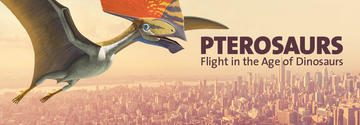The largest exhibition ever mounted in the United States about these flying reptiles, Pterosaurs highlights the latest research by museum scientists and paleontologists.
The exhibit also features rare pterosaur fossils from Germany, the United States, and Brazil as well as casts, life-size models, videos, and interactive exhibits on the mechanics of pterosaur flight.
Pterosaurs first appeared about 220 million years ago, according to the museum, and evolved into a diverse group with more than 150 species known from the fossil record: some with long slender jaws with needle sharp teeth, some with extravagant crests, and some with extraordinarily long wings, making these the largest flying animals ever to have existed.
A full-size model of Tropeognathus mesembrinus, with a wingspan of more than 25 feet, will soar over visitors at the entrance to the exhibition; a full-size model of the 33-foot-wingspan Quetzalcoatlus northropi will be on view as well.
For paleontologists, pterosaurs present a special challenge: their thin and fragile bones preserve poorly, rendering their fossils relatively rare. Pterosaur fossils on view will include the spectacular Rhamphorhynchus specimen (the Dark Wing), which features preserved wing membrane and has never been exhibited outside of Germany.
Pterosaurs also moved on land, walked on four limbs and congregated in flocks. But flight is a special area of focus for the exhibition, which draws comparisons between pterosaurs and contemporary winged vertebrates, birds and bats; showcases the principles of aerodynamics in an interactive virtual wind tunnel; and offers visitors the chance to “pilot” a flying pterosaur over a prehistoric landscape.


 Dates: July 3rd to October 2nd
Dates: July 3rd to October 2nd










